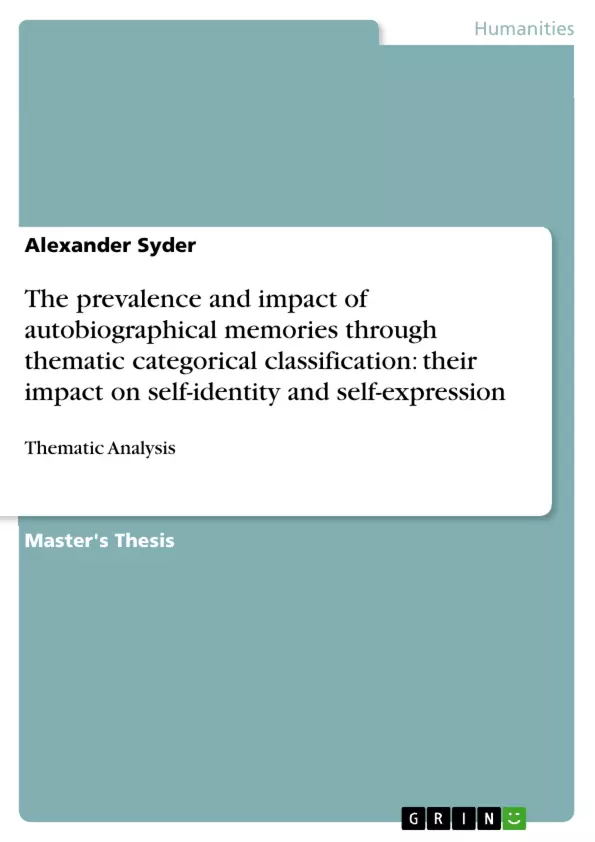
The prevalence and impact of autobiographical memories through thematic categorical classification: their impact on self-identity and self-expression
Masterarbeit, 2015
71 Seiten, Note: Merit
Leseprobe
Inhaltsverzeichnis (Table of Contents)
- Introduction
- Historical background to Autobiographical Memory
- Theoretical basis for autobiographical memory
- Justification for research categorical factors
- Cognitive and Neurobiological approach to autobiographical memory
- Theoretical basis for the 'self' and memory
- Methodological implications for autobiographical memory studies
- Social, developmental and cultural implications
- Theoretical basis for 'episodic future thinking'
- Hypothesis: Key points
- Methodology
- Results
- Discussion
Zielsetzung und Themenschwerpunkte (Objectives and Key Themes)
This study investigates the impact of autobiographical memories on future thinking and decision-making. It explores the relationship between memory, self-identity, and self-expression through a mixed-methods approach, combining quantitative and qualitative data analysis. The research aims to understand how autobiographical memories function in shaping personal narratives and influencing future orientations.
- The role of autobiographical memory in shaping self-identity and self-expression.
- The relationship between autobiographical memory and future thinking/decision-making.
- The influence of specific types of autobiographical memories (e.g., family, school memories) on future orientations.
- The cognitive and neurobiological underpinnings of autobiographical memory.
- The social, developmental, and cultural factors that influence autobiographical memory.
Zusammenfassung der Kapitel (Chapter Summaries)
Introduction: This chapter introduces the concept of autobiographical memory (AM) as a unique feature of episodic memory, differentiating it from other forms of memory recall. It establishes the significance of AM in constructing personal narratives and influencing self-perception, highlighting the role of "autonoetic awareness" and "mental time travel" in accessing and utilizing past experiences. The chapter emphasizes the complexity of AM, acknowledging its susceptibility to biases while maintaining its crucial role in shaping individual identities and future orientations. It sets the stage for investigating how these memories directly affect future thinking and decision-making.
Historical background to Autobiographical Memory: This section would delve into the historical development of the concept of autobiographical memory within psychological literature, tracing its evolution from earlier conceptions of memory to the current understanding of its multifaceted nature. It would likely discuss key figures and influential research that contributed to shaping the theoretical framework within which the study operates. The historical context would provide a valuable foundation for understanding the current research on AM and its applications.
Theoretical basis for autobiographical memory: This chapter likely presents established theories that explain the structure and function of autobiographical memory. It would detail different theoretical models and frameworks used to comprehend how memories are encoded, stored, and retrieved, highlighting the interplay of cognitive, emotional, and social factors. Key concepts and theoretical debates surrounding the nature of AM would be explored, providing the theoretical groundwork for the research methodology and interpretation of results.
Methodology: This chapter details the research design, participant selection, data collection methods, and analytical procedures employed in the study. It describes the quantitative and qualitative methodologies used, including the specific instruments and techniques to collect data (e.g., surveys, interviews). It would also justify the choice of these methods and address potential limitations, emphasizing the rigor and validity of the research approach. Ethical considerations related to data collection and participant rights are also outlined here.
Results: This chapter presents the findings of the study based on the data collected through both quantitative and qualitative methods. It reports the statistical analyses performed on the quantitative data and provides a detailed account of the thematic analysis of the qualitative data. The results section aims to objectively present the findings without interpretation, offering a comprehensive overview of the data obtained in the study. This would include discussion of response patterns and any significant relationships observed between variables.
Schlüsselwörter (Keywords)
Autobiographical memory, self-identity, self-expression, future thinking, decision-making, episodic memory, thematic analysis, mixed methods, qualitative research, quantitative research, memory biases, personal narrative, social psychology.
Frequently Asked Questions: A Comprehensive Language Preview
What is the main focus of this research?
This research investigates the impact of autobiographical memories on future thinking and decision-making. It explores the relationship between memory, self-identity, and self-expression using a mixed-methods approach (combining quantitative and qualitative data analysis).
What are the key themes explored in this study?
Key themes include the role of autobiographical memory in shaping self-identity and self-expression; the relationship between autobiographical memory and future thinking/decision-making; the influence of specific memory types (e.g., family, school memories) on future orientations; the cognitive and neurobiological underpinnings of autobiographical memory; and the social, developmental, and cultural factors influencing autobiographical memory.
What is the structure of the language preview?
The preview provides a comprehensive overview, including a table of contents, objectives and key themes, chapter summaries, and keywords. It details the research aims and methodology, offering insights into the historical background, theoretical basis, and methodological implications of the study on autobiographical memory.
What methodologies are employed in this research?
The study utilizes a mixed-methods approach, integrating both quantitative and qualitative research methods. The specific methods used for data collection and analysis are detailed in the "Methodology" chapter. This includes quantitative analysis of data and qualitative thematic analysis.
What are the key findings of the study (as presented in the preview)?
The preview does not present specific results, only stating that the "Results" chapter will present the findings from both quantitative and qualitative data analyses. The chapter will report statistical analyses of quantitative data and thematic analysis of the qualitative data.
What are the key theoretical frameworks used in this research?
The preview mentions that established theories explaining the structure and function of autobiographical memory will be presented, including different theoretical models and frameworks that address memory encoding, storage, and retrieval. The interplay of cognitive, emotional, and social factors will be highlighted.
What are the chapter summaries included in this preview?
The preview includes summaries for the Introduction, Historical background to Autobiographical Memory, Theoretical basis for autobiographical memory, and Methodology chapters. It indicates that the Results chapter will objectively present findings from both quantitative and qualitative data, while the Discussion chapter is not summarized.
What are the keywords associated with this research?
Keywords include: Autobiographical memory, self-identity, self-expression, future thinking, decision-making, episodic memory, thematic analysis, mixed methods, qualitative research, quantitative research, memory biases, personal narrative, social psychology.
What is the significance of autobiographical memory according to this preview?
The preview emphasizes the significance of autobiographical memory in constructing personal narratives, influencing self-perception, and shaping individual identities and future orientations. It highlights the role of "autonoetic awareness" and "mental time travel" in accessing and utilizing past experiences.
For whom is this language preview intended?
The preview is intended for academic use, supporting the analysis of themes in a structured and professional manner. The information provided is meant to give a clear understanding of the research scope and findings.
Details
- Titel
- The prevalence and impact of autobiographical memories through thematic categorical classification: their impact on self-identity and self-expression
- Untertitel
- Thematic Analysis
- Hochschule
- Sheffield Hallam University
- Veranstaltung
- MSc Psychology
- Note
- Merit
- Autor
- Alexander Syder (Autor:in)
- Erscheinungsjahr
- 2015
- Seiten
- 71
- Katalognummer
- V337634
- ISBN (eBook)
- 9783668273030
- ISBN (Buch)
- 9783668273047
- Dateigröße
- 865 KB
- Sprache
- Englisch
- Anmerkungen
- A level 7 dissertation conducted at Sheffield Hallam University. Masters level.
- Schlagworte
- autobiographical memories Masters Psychology Level 7 GBC thematic analysis dissertation
- Produktsicherheit
- GRIN Publishing GmbH
- Preis (Ebook)
- US$ 17,99
- Preis (Book)
- US$ 25,99
- Arbeit zitieren
- Alexander Syder (Autor:in), 2015, The prevalence and impact of autobiographical memories through thematic categorical classification: their impact on self-identity and self-expression, München, Page::Imprint:: GRINVerlagOHG, https://www.diplomarbeiten24.de/document/337634
- Autor werden
- Ihre Optionen
- Vertriebskanäle
- Premium Services
- Autorenprofil
- Textarten und Formate
- Services für Verlage, Hochschulen, Unternehmen

- © GRIN Publishing GmbH.
- Alle Inhalte urheberrechtlich geschützt. Kopieren und verbreiten untersagt.
- info@grin.com
- AGB
- Open Publishing
Der GRIN Verlag hat sich seit 1998 auf die Veröffentlichung akademischer eBooks und Bücher spezialisiert. Der GRIN Verlag steht damit als erstes Unternehmen für User Generated Quality Content. Die Verlagsseiten GRIN.com, Hausarbeiten.de und Diplomarbeiten24 bieten für Hochschullehrer, Absolventen und Studenten die ideale Plattform, wissenschaftliche Texte wie Hausarbeiten, Referate, Bachelorarbeiten, Masterarbeiten, Diplomarbeiten, Dissertationen und wissenschaftliche Aufsätze einem breiten Publikum zu präsentieren.
Kostenfreie Veröffentlichung: Hausarbeit, Bachelorarbeit, Diplomarbeit, Dissertation, Masterarbeit, Interpretation oder Referat jetzt veröffentlichen!
- GRIN Verlag GmbH
-
- Nymphenburger Str. 86
- 80636
- Munich, Deutschland
- +49 89-550559-0
- +49 89-550559-10
- info@grin.com
-









